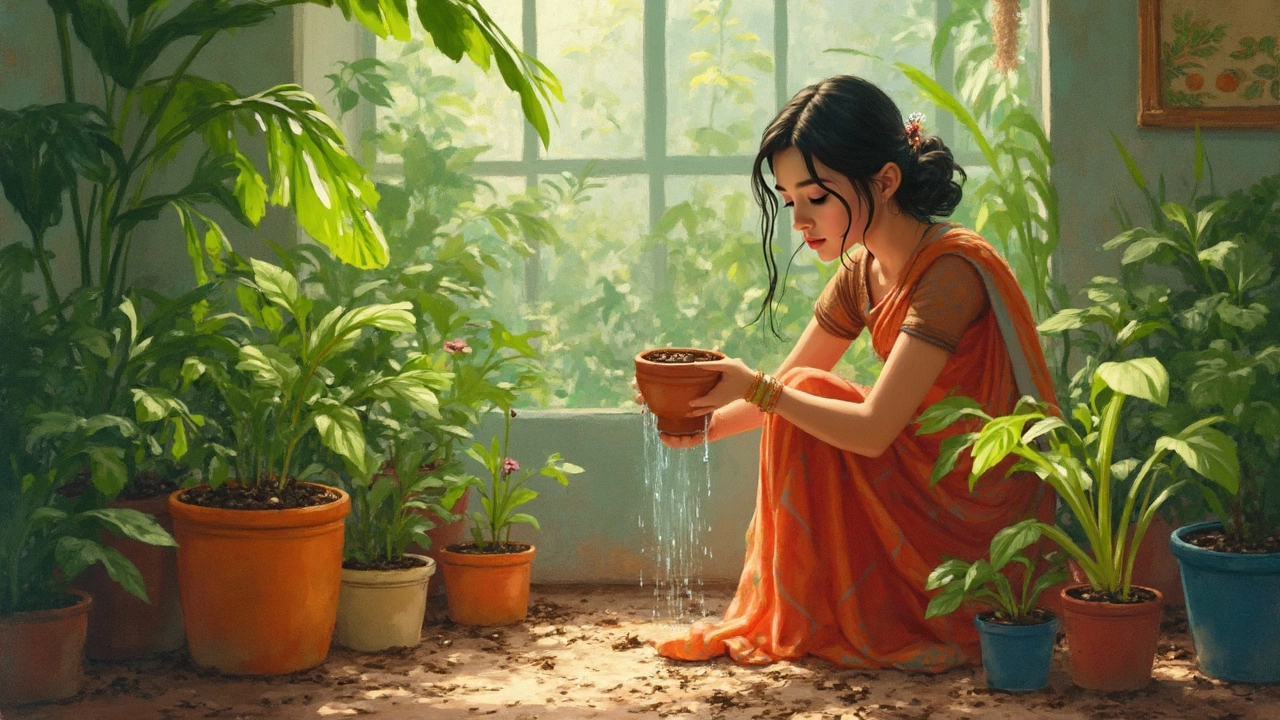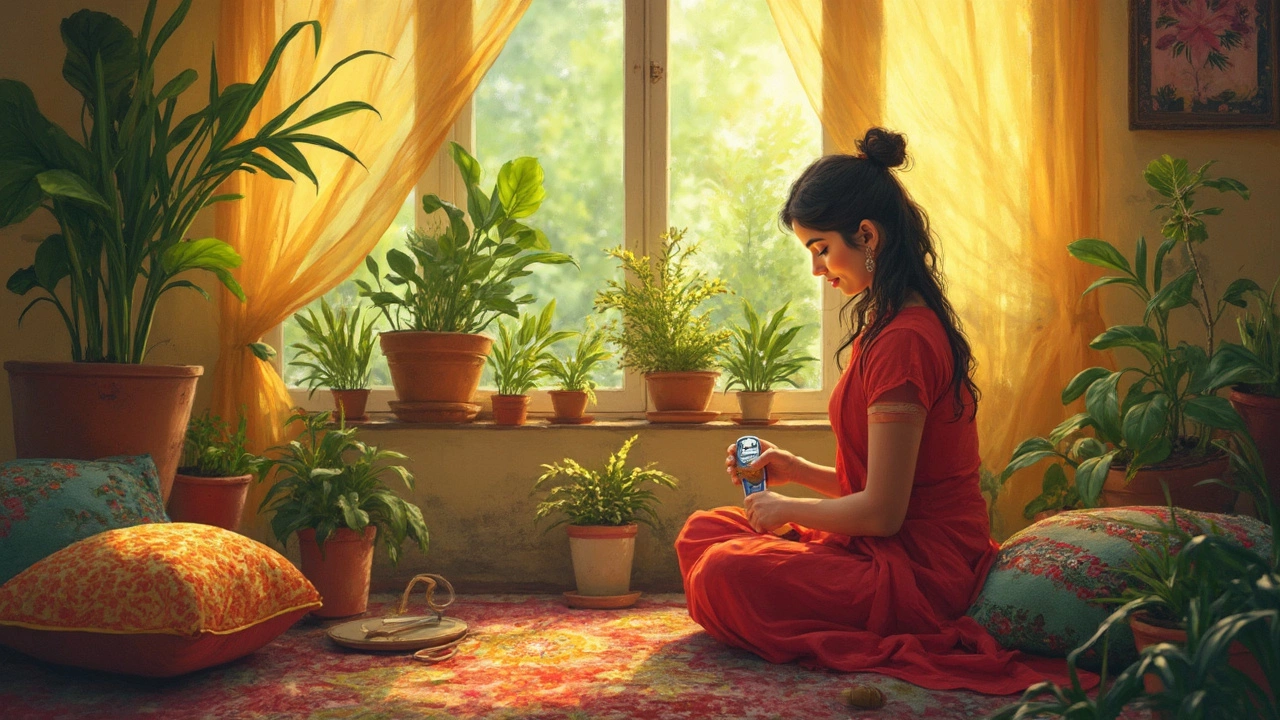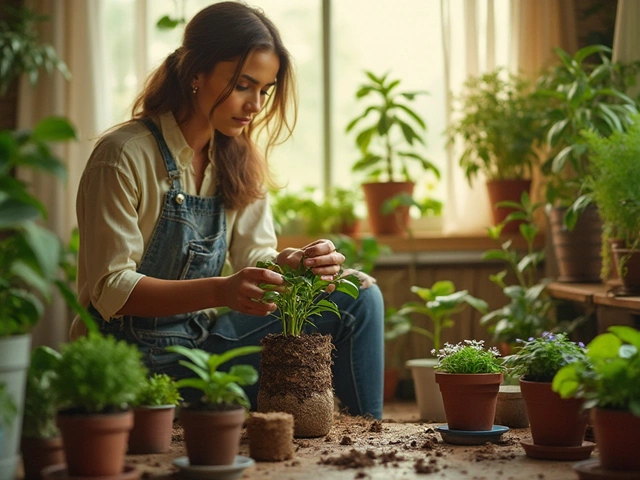Spot Overwatering vs Underwatering: Your Indoor Plant's Vital Signs

Spot Overwatering vs Underwatering: Your Indoor Plant's Vital Signs
Ever glanced over at your indoor green buddies and wondered if they're getting the right amount of water? You're definitely not alone. Plants, like people, have their ways of telling us what they need and what they don’t. But reading their signals can be tricky, especially when it comes to watering.
Overwatering is one of the most common culprits behind unhappy plants. You might notice yellowing leaves or a plant that's droopy, even though you're sure you've watered it. On the flip side, underwatering shows up as crispy, brown leaf edges and stubbornly dry soil. The trick is knowing what signs to look for—so let's get into it.
- Recognizing Overwatering Symptoms
- Spotting Underwatering Signs
- Soil and Pot Considerations
- Rescue Tips for Struggling Plants
- Balancing Watering Techniques
Recognizing Overwatering Symptoms
Overwatering is like giving your plants too much love. It sounds harmless, but it can be the main reason why your beloved greenery might be feeling under the weather. When your plants get too much water, their roots can't breathe, leading to several telltale signs.
Common Symptoms of Overwatered Plants
- Yellowing Leaves: A clear indicator that something's off. If the leaves are turning yellow even though you've been diligent with watering, it might be a sign that there's too much H2O in the pot.
- Mushy or Soft Stems: Check the stems. If they feel mushy to the touch, it's a red flag for excess moisture.
- Root Rot: The ultimate villain of overwatering. Roots will appear brown or black and have a foul smell. This rot can be pretty sneaky and tough to tackle once it sets in.
- Mold or Mildew: Finding mold or fungal growth on the soil surface is your plant’s cry for help to back off on watering.
- Drooping: A drooping plant could mean it's had too much to drink, even if it seems counterintuitive.
The Science of Overwatering
The problem boils down to oxygen. Plants need air at their roots, and drowning them in water deprives them of this essential element. Roots sitting in waterlogged soil can't absorb moisture and nutrients effectively, leading to distress signals.
| Sign | Possible Cause |
|---|---|
| Yellowing Leaves | Excess Water |
| Mushy Stems | Root Issues |
| Mold on Soil | Overwatering |
Understanding these symptoms is half the battle. In our next sections, we’ll explore how you can correct overwatering and bring your distressed plants back to their happy green selves.
Spotting Underwatering Signs
Is your indoor plant looking a bit rough around the edges? It might be crying out for water. Underwatering can sneak up on you and slowly turn your vibrant houseplants into sad, brown versions of their former selves. Let’s break down how to catch these signs before it's too late.
Visible Signs to Look Out For
Dried-up leaf tips or edges are classic underwatering signals. It’s like your plant’s SOS call saying, “Hey, I’m parched over here!” The entire leaf can also curl or become brittle, making it easy to snap off when touched.
If you notice the soil pulling away from the sides of the pot, it’s a dead giveaway your plant is thirsting for a drink. The soil should ideally remain slightly moist, but when it gets too dry, it contracts and leaves gaps.
Check the Weight
Here’s a quick trick: gently lift your potted plant. Does it feel unusually light? That’s a good indicator it needs watering. A well-watered plant has a bit of heft, thanks to moisture content. Give this method a try whenever you’re unsure.
Watch for Growth Stalls
While plants naturally grow slower in certain seasons, if yours seems to be perpetually in a state of pause, underwatering could be the reason. Regular observation will help you get to know what's "normal" for your plants.
Setting a Watering Schedule
To keep things balanced, consider creating a simple watering schedule. Track how long it takes for the soil to get dry enough for a drink. It’s a little bit of trial and error, but soon you’ll find the sweet spot that suits your specific indoor conditions and plant type.

Soil and Pot Considerations
When it comes to indoor plants, soil and pot selection can make a huge difference in keeping your greenery lush and vibrant. One size doesn't fit all here, as every plant has its own set of soil and pot preferences.
Choosing the Right Soil
A good rule of thumb is to use soil that matches your plant’s natural habitat. Cacti and succulents enjoy a gritty mix that drains easily, while tropical plants thrive in nutrient-rich soil. Most indoor plants prefer a well-draining potting mix to prevent root rot—all thanks to excess moisture.
Selecting the Perfect Pot
The pot you choose for your plant can impact its health more than you might think. Size matters! Too big, and your plant may stay damp for too long; too small, and it might dry out too quickly. Always go for pots with drainage holes, ensuring excess water can escape instead of sitting at the bottom.
Repotting Basics
Don't forget about repotting. As plants grow, they outgrow their pots. Signs like roots poking out from drainage holes usually signal it’s time for an upgrade. Aim to repot every year or two when your plant seems a bit crowded.
| Pot Size | Ideal Plant Height |
|---|---|
| 4 inches | Up to 10 inches |
| 6 inches | Up to 14 inches |
| 8 inches | Up to 18 inches |
This little table can help guide your choice on pot size based on your plant's current size.
By getting the soil and pot mix just right, you'll set your plants up for a longer, healthier life. Remember, understanding their needs helps you bring out the best in them—and keeps your indoor garden thriving!
Rescue Tips for Struggling Plants
If your indoor plant looks like it's seen better days, don't worry—you've got a chance to nurse it back to life. First, let's figure out if you've been overwatering or underwatering your plant. This will help you decide the right approach to revive it.
Step 1: Confirm the Culprit
Gently take the plant out of its pot and inspect the roots. Mushy and dark roots indicate overwatering, while dry, whitish roots spell underwatering. Check the soil too—soggy or dry will paint a clearer picture.
Step 2: Address Overwatering
- Trim any mushy, blackened roots using clean scissors. Remove dead leaves.
- Allow the plant to air dry for a few hours.
- Repot with fresh potting mix designed for indoor plants. Ensure the pot has a good drainage system.
- Water sparingly till the plant starts showing signs of recovery.
Step 3: Fix Underwatering
- Start by giving the plant a good soak. Place the pot in a tray of water for about 30 minutes, letting it drink from the bottom.
- Maintain a regular watering schedule. Feel the soil's top few inches—water only when it's dry.
- Mulch the soil surface to help retain moisture.
Step 4: General Care Tips
Regardless of the initial issue, providing the right environment is essential. Indoor plants need adequate light—consider moving your plant to a brighter spot. Avoid drafts or locations too close to heating or cooling vents.
Patience is key. Plants may take several weeks to bounce back. Keep an eye on their progress and adjust your care routine as they recover. And remember, a little love goes a long way when it comes to plant care!

Balancing Watering Techniques
Achieving the right balance in watering is essential to thriving indoor plants care. It's not just about pouring water every now and then. You need to tune into your plant's needs and adapt your approach based on a few simple methods.
Observe and Adapt
Your plants will give you clues. For instance, during the winter, you probably need to cut back on watering because plants grow slower and need less moisture. In the sunny days of summer, they'll likely need more frequent watering. Notice how the soil feels—if it’s damp and clumpy, you're good. If it's dry, it may be time for a drink.
Timing Matters
Watering early in the day is usually best. It gives the plant time to absorb moisture before the temperature rises. Nighttime watering increases the risks of mold since the water doesn't have time to evaporate. A morning routine with your plants can keep them hydrated and healthy.
The Finger Test
This one's a classic. Just stick your finger about an inch into the soil. Feels dry? Time to water. Feels wet? Let it be. This simple test takes out the guesswork and saves your plants from being too lush or too parched.
- Check the Pot: Ensure your pot has drainage holes. Stagnant water can lead to root rot, a common issue in overwatering.
- Use the Right Soil: A mix that's too dense retains too much moisture, while too sandy a mix might dry too fast. Aim for a well-balanced soil.
Measuring Water
If you're a fan of numbers, try measuring the amount of water you give. A general rule is to water until you see it coming out of the drainage holes, ensuring even distribution. This approach helps equally for both overwatering and underwatering.
Stats on Water Needs
Each plant has its quirks. Consider this mini-guide:
| Plant Type | Water Frequency |
|---|---|
| Succulents | Every 2-3 weeks |
| Ferns | Once a week |
| Pothos | Every 1-2 weeks |
Balancing water isn't rocket science. With a bit of attention and these practical tips, you’ll nail the perfect water routine. And watch your indoor jungle flourish like a pro!
About
Gardener Support India is your go-to online destination for expert advice on gardening and horticultural services in India. Whether you're a beginner or an experienced gardener, our platform offers extensive resources, tips, and support tailored to Indian climates and plant species. Explore a wide range of guides on plant care, sustainable gardening practices, and innovative gardening solutions. Connect with local experts to enhance your gardening experience and maintain a flourishing garden. Our dedicated services aim to empower Indian gardeners with the knowledge and tools needed for a successful gardening journey.
Latest Posts


Should You Use Landscape Fabric Under Raised Beds?
By Alden Thorne Mar 1, 2025

Common Indoor Plant Care Mistakes You Should Avoid
By Alden Thorne Jan 3, 2025

Best Soil for Rice Cultivation: Secrets to Thriving Paddies
By Alden Thorne Jul 17, 2025

Write a comment